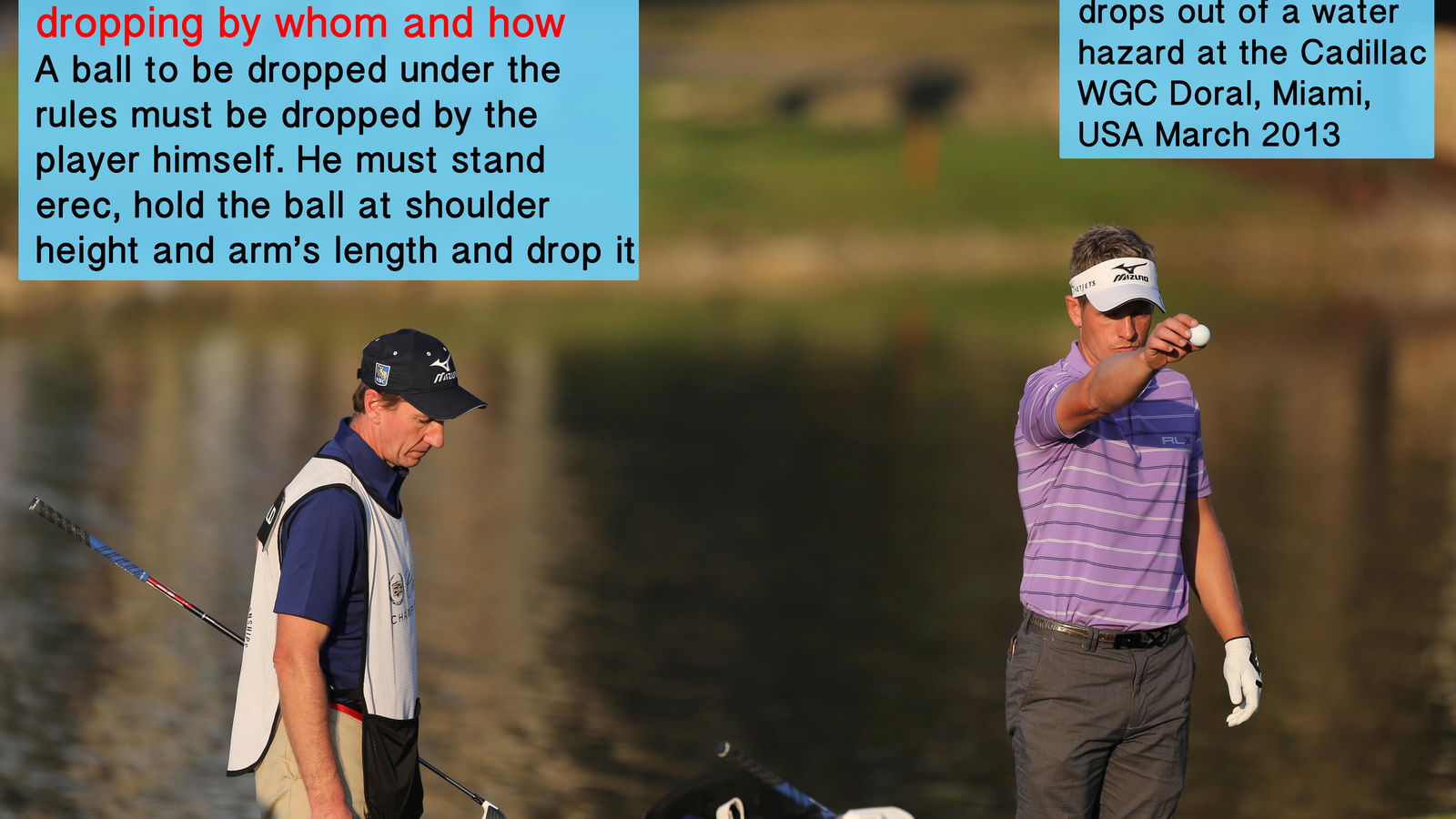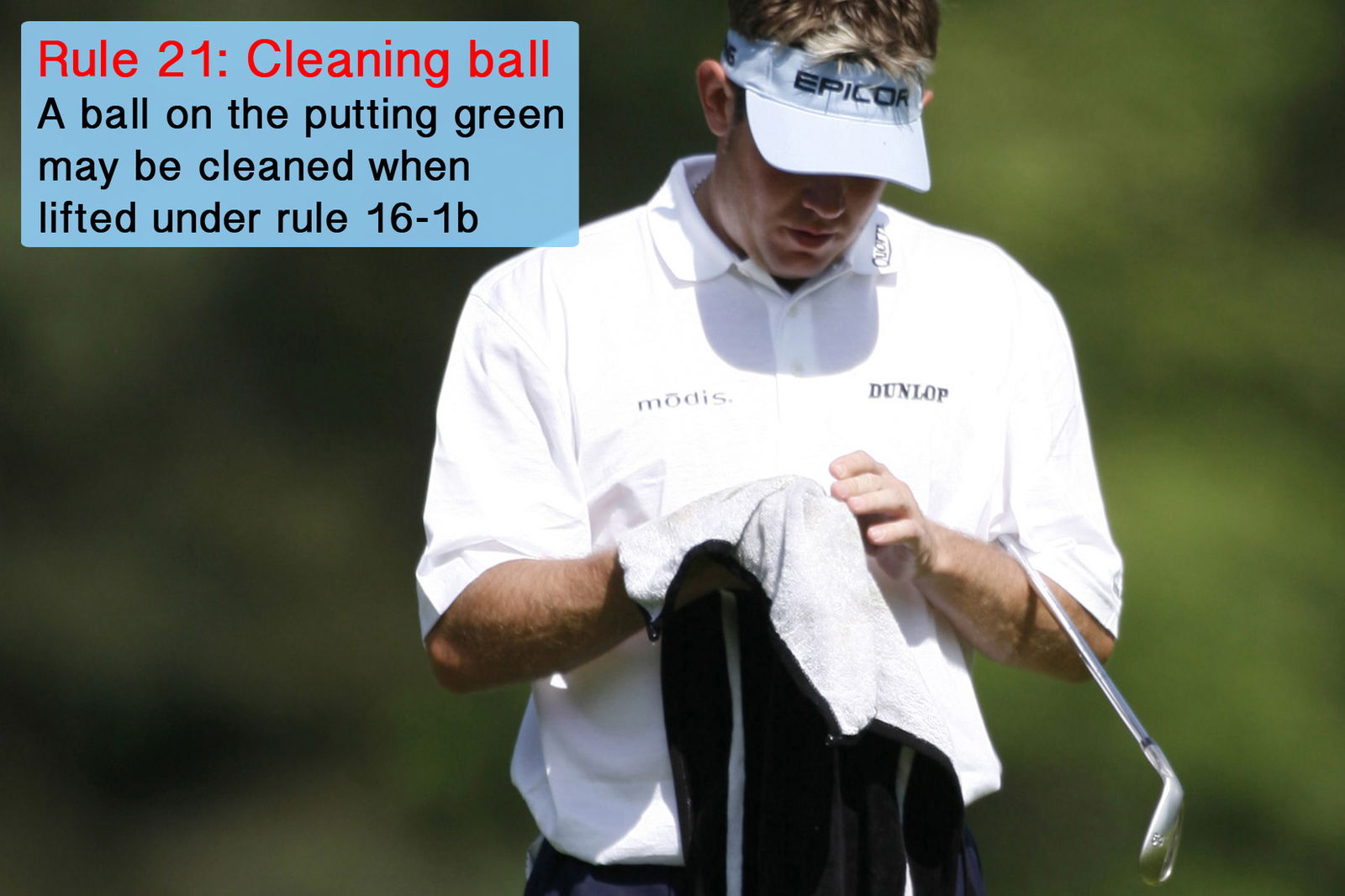Golf Rule 20: Lifting, dropping and placing; playing from wrong place
Where and when do you drop your ball? Find out in this rules article

Rule 20: Lifting, dropping and placing; playing from wrong place
One of the official 34 Rules of Golf.
20-1: Lifting and Marking
A ball to be lifted under the Rules may be lifted by the player, his partner or another person authorised by the player. In any such case, the player is responsible for any breach of the Rules.
The position of the ball must be marked before it is lifted under a Rule that requires it to be replaced. If it is not marked, the player incurs a penalty of one stroke and the ball must be replaced. If it is not replaced, the player incurs the general penalty for breach of this Rule but there is no additional penalty under Rule 20-1.
If a ball or ball-marker is accidentally moved in the process of lifting the ball under a Rule or marking its position, the ball or ball-marker must be replaced. There is no penalty, provided the movement of the ball or ball-marker is directly attributable to the specific act of marking the position of or lifting the ball. Otherwise, the player incurs a penalty of one stroke under this Rule or Rule 18-2a.
Exception: If a player incurs a penalty for failing to act in accordance with Rule 5-3 or 12-2, there is no additional penalty under Rule 20-1.
Note: The position of a ball to be lifted should be marked by placing a ball-marker, a small coin or other similar object immediately behind the ball. If the ball-marker interferes with the play, stance or stroke of another player, it should be placed one or more clubhead-lengths to one side.
*PENALTY FOR BREACH OF RULE 20-1, 20-2 or 20-3:
Match play - Loss of hole; Stroke play - Two strokes.
*If a player makes a stroke at a ball substituted under one of these Rules when such substitution is not permitted, he incurs the general penalty for breach of that Rule, but there is no additional penalty under that Rule. If a player drops a ball in an improper manner and plays from a wrong place or if the ball has been put into play by a person not permitted by the Rules and then played from a wrong place, see Note 3 to Rule 20-7c.
20-2: Dropping and Re-Dropping
a) By Whom and How
A ball to be dropped under the Rules must be dropped by the player himself. He must stand erect, hold the ball at shoulder height and arm’s length and drop it. If a ball is dropped by any other person or in any other manner and the error is not corrected as provided in Rule 20-6, the player incurs a penalty of one stroke.
If the ball, when dropped, touches any person or the equipment of any player before or after it strikes a part of the course and before it comes to rest, the ball must be re-dropped, without penalty. There is no limit to the number of times a ball must be re-dropped in these circumstances.
(Taking action to influence position or movement of ball – see Rule 1-2)
b) Where to Drop
When a ball is to be dropped as near as possible to a specific spot, it must be dropped not nearer the hole than the specific spot which, if it is not precisely known to the player, must be estimated.
A ball when dropped must first strike a part of the course where the applicable Rule requires it to be dropped. If it is not so dropped, Rules 20-6 and 20-7 apply.
c) When to Re-Drop
A dropped ball must be re-dropped, without penalty, if it:
(i) rolls into and comes to rest in a hazard;
(ii) rolls out of and comes to rest outside a hazard;
(iii) rolls onto and comes to rest on a putting green;
(iv) rolls and comes to rest out of bounds;
(v) rolls to and comes to rest in a position where there is interference by the condition from which relief was taken under Rule 24-2b (immovable obstruction), Rule 25-1 (abnormal ground conditions), Rule 25-3 (wrong putting green) or a Local Rule (Rule 33-8a), or rolls back into the pitch-mark from which it was lifted under Rule 25-2 (embedded ball);
(vi) rolls and comes to rest more than two club-lengths from where it first struck a part of the course; or
(vii) rolls and comes to rest nearer the hole than:
(a) its original position or estimated position (see Rule 20-2b) unless otherwise permitted by the Rules; or
(b) the nearest point of relief or maximum available relief (Rule 24-2, 25-1 or 25-3); or
(c) the point where the original ball last crossed the margin of the water hazard or lateral water hazard (Rule 26-1).
If the ball when re-dropped rolls into any position listed above, it must be placed as near as possible to the spot where it first struck a part of the course when re-dropped.
If the ball when re-dropped rolls into any position listed above, it must be placed as near as possible to the spot where it first struck a part of the course when re-dropped.
Note 1: If a ball when dropped or re-dropped comes to rest and subsequently moves, the ball must be played as it lies, unless the provisions of any other Rule apply.
Note 2: If a ball to be re-dropped or placed under this Rule is not immediately recoverable, another ball may be substituted.
(Use of dropping zone - see Appendix 1, Part B, Section 8)
PENALTY FOR BREACH OF RULE 20-1, 20-2 or 20-3:
Match play – Loss of hole; Stroke play – Two strokes.
*If a player makes a stroke at a ball substituted under one of these Rules when such substitution is not permitted, he incurs the general penalty for breach of that Rule, but there is no additional penalty under that Rule. If a player drops a ball in an improper manner and plays from a wrong place or if the ball has been put into play by a person not permitted by the Rules and then played from a wrong place, see Note 3 to Rule 20-7c.
20-3 - Placing and Replacing
a) By Whom and Where
A ball to be placed under the Rules must be placed by the player or his partner.
A ball to be replaced under the Rules must be replaced by any one of the following: (i) the person who lifted or moved the ball, (ii) the player, or (iii) the player's partner. The ball must be placed on the spot from which it was lifted or moved. If the ball is placed or replaced by any other person and the error is not corrected as provided in Rule 20-6, the player incurs a penalty of one stroke. In any such case, the player is responsible for any other breach of the Rules that occurs as a result of the placing or replacing of the ball.
If a ball or ball-marker is accidentally moved in the process of placing or replacing the ball, the ball or ball-marker must be replaced. There is no penalty, provided the movement of the ball or ball-marker is directly attributable to the specific act of placing or replacing the ball or removing the ball-marker. Otherwise, the player incurs a penalty of one stroke under Rule 18-2a or 20-1.
If a ball to be replaced is placed other than on the spot from which it was lifted or moved and the error is not corrected as provided in Rule 20-6, the player incurs the general penalty, loss of hole in match play or two strokes in stroke play, for a breach of the applicable Rule.
b) Lie of Ball to be Placed or Replaced Altered
If the original lie of a ball to be placed or replaced has been altered:
(i) except in a hazard, the ball must be placed in the nearest lie most similar to the original lie that is not more than one club-length from the original lie, not nearer the hole and not in a hazard;
(ii) in a water hazard, the ball must be placed in accordance with Clause (i) above, except that the ball must be placed in the water hazard;
(iii) in a bunker, the original lie must be re-created as nearly as possible and the ball must be placed in that lie.
Note: If the original lie of a ball to be placed or replaced has been altered and it is impossible to determine the spot where the ball is to be placed or replaced, Rule 20-3b applies if the original lie is known, and Rule 20-3c applies if the original lie is not known.
Exceptions: If the player is searching for or identifying a ball covered by sand - see Rule 12-1a.
c) Spot Not Determinable
If it is impossible to determine the spot where the ball is to be placed or replaced:
(i) through the green, the ball must be dropped as near as possible to the place where it lay but not in a hazard or on a putting green;
(ii) in a hazard, the ball must be dropped in the hazard as near as possible to the place where it lay;
(iii) on the putting green, the ball must be placed as near as possible to the place where it lay but not in a hazard.
Exception: When resuming play (Rule 6-8d), if the spot where the ball is to be placed is impossible to determine, it must be estimated and the ball placed on the estimated spot.
d) Ball Fails to Come to Rest on Spot
If a ball when placed fails to come to rest on the spot on which it was placed, there is no penalty and the ball must be replaced. If it still fails to come to rest on that spot:
(i) except in a hazard, it must be placed at the nearest spot where it can be placed at rest that is not nearer the hole and not in a hazard;
(ii) in a hazard, it must be placed in the hazard at the nearest spot where it can be placed at rest that is not nearer the hole.
If a ball when placed comes to rest on the spot on which it is placed, and it subsequently moves, there is no penalty and the ball must be played as it lies, unless the provisions of any other Rule apply.
PENALTY FOR BREACH OF RULE 20-1, 20-2 or 20-3:
Match play – Loss of hole; Stroke play – Two strokes.
*If a player makes a stroke at a ball substituted under one of these Rules when such substitution is not permitted, he incurs the general penalty for breach of that Rule, but there is no additional penalty under that Rule. If a player drops a ball in an improper manner and plays from a wrong place or if the ball has been put into play by a person not permitted by the Rules and then played from a wrong place, see Note 3 to Rule 20-7c.
20-4 - When Ball Dropped or Placed is in Play
If the player’s ball in play has been lifted, it is again in play when dropped or placed.
A substituted ball becomes the ball in play when it has been dropped or placed.
(Ball incorrectly substituted – see Rule 15-2)
(Lifting ball incorrectly substituted, dropped or placed – see Rule 20-6)
20-5 - Making Next Stroke from Where Previous Stroke Made
When a player elects or is required to make his next stroke from where a previous stroke was made, he must proceed as follows:
(a) On the Teeing Ground: The ball to be played must be played from within the teeing ground. It may be played from anywhere within the teeing ground and may be teed.
(b) Through the Green: The ball to be played must be dropped and when dropped must first strike a part of the course through the green.
(c) In a Hazard: The ball to be played must be dropped and when dropped must first strike a part of the course in the hazard.
(d) On the Putting Green: The ball to be played must be placed on the putting green.
PENALTY FOR BREACH OF RULE 20-5:
Match play – Loss of hole; Stroke play – Two strokes.
20-6 - Lifting Ball Incorrectly Substituted, Dropped or Placed
A ball incorrectly substituted, dropped or placed in a wrong place or otherwise not in accordance with the Rules but not played may be lifted, without penalty, and the player must then proceed correctly.
20-7 - Playing from Wrong Place
a) General
A player has played from a wrong place if he makes a stroke at his ball in play:
(i) on a part of the course where the Rules do not permit a stroke to be made or a ball to be dropped or placed; or
(ii) when the Rules require a dropped ball to be re-dropped or a moved ball to be replaced.
Note: For a ball played from outside the teeing ground or from a wrong teeing ground – see Rule 11-4.
b) Match Play
If a player makes a stroke from a wrong place, he loses the hole.
c) Stroke Play
If a competitor makes a stroke from a wrong place, he incurs a penalty of two strokes under the applicable Rule. He must play out the hole with the ball played from the wrong place, without correcting his error, provided he has not committed a serious breach (see Note 1).
If a competitor becomes aware that he has played from a wrong place and believes that he may have committed a serious breach, he must, before making a stroke on the next teeing ground, play out the hole with a second ball played in accordance with the Rules. If the hole being played is the last hole of the round, he must declare, before leaving the putting green, that he will play out the hole with a second ball played in accordance with the Rules.
If the competitor has played a second ball, he must report the facts to the Committee before returning his score card; if he fails to do so, he is disqualified. The Committee must determine whether the competitor has committed a serious breach of the applicable Rule. If he has, the score with the second ball counts and the competitor must add two penalty strokes to his score with that ball. If the competitor has committed a serious breach and has failed to correct it as outlined above, he is disqualified.
Note 1: A competitor is deemed to have committed a serious breach of the applicable Rule if the Committee considers he has gained a significant advantage as a result of playing from a wrong place.
Note 2: If a competitor plays a second ball under Rule 20-7c and it is ruled not to count, strokes made with that ball and penalty strokes incurred solely by playing that ball are disregarded. If the second ball is ruled to count, the stroke made from the wrong place and any strokes subsequently taken with the original ball including penalty strokes incurred solely by playing that ball are disregarded.
Note 3: If a player incurs a penalty for making a stroke from a wrong place, there is no additional penalty for:
(a) substituting a ball when not permitted;
(b) dropping a ball when the Rules require it to be placed, or placing a ball when the Rules require it to be dropped;
(c) dropping a ball in an improper manner; or
(d) a ball being put into play by a person not permitted to do so under the Rules.

